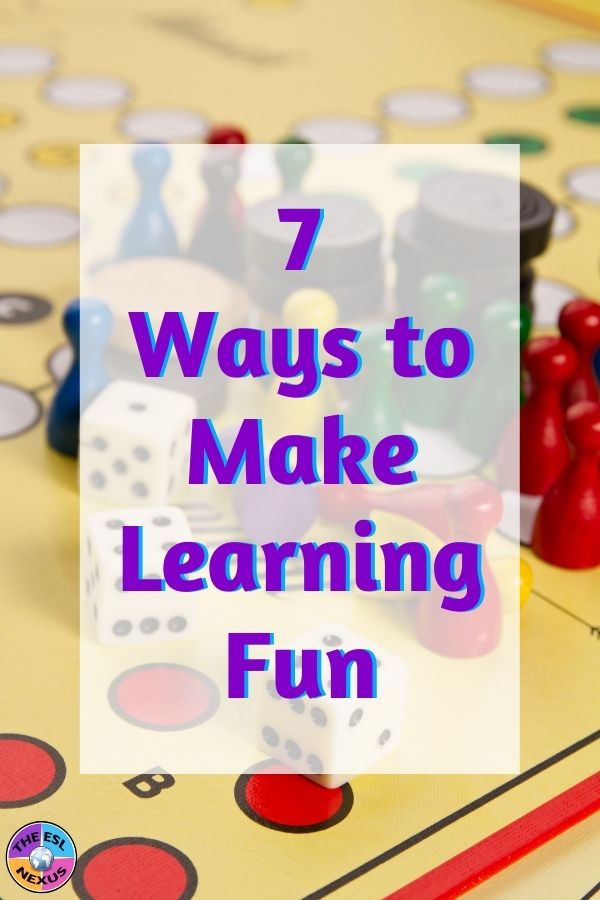Making learning fun is more than just playing games in your classroom. Although, playing games has its place and there are many educational games that teach content. At the end of this blog post, I’ll share some of the games I especially like. But what I am primarily focusing on in this blog post is how to teach content knowledge in ways that make it easier and more fun for them to learn. Because when students are engaged in what they are learning, they will learn it better. I’ll start off with some easy-to-implement ideas and examples, then offer some suggestions that are more involved or take more time to implement.
 |
| Learning and fun are not mutually exclusive! source: The ESL Nexus |
1) Create Lessons that Use a Combination of Multiple Intelligences
This is based on Howard Gardner’s Theory of Multiple Intelligences, which at its simplest says that students have different strengths and to optimize all students’ learning, teachers should include more than one mode in their lessons to reach every student. You can do this by introducing a lesson, then giving your students a task that utilizes one intelligence, followed by a related task that uses another intelligence. Ways to do this are to have students small group read a text, which addresses Language. Then have students create a presentation about the information in the text. It could include a song, which addresses Music. It could be a poster drawn by students, which addresses Art. It could be a podcast or video, which addresses Technology.
Example 1:
When teaching my World Geography class, I liked to play music from the region students were learning about. I had the music on as they walked into the classroom and also when they were working on their own at their desks on various tasks.
Example 2:
When I was supplementing a Language Arts teacher’s lessons about the novel The Lion, the Witch, and the Wardrobe, I reviewed each chapter with my ELLs to make sure they understood the plot. For one chapter, I brought in Turkish Delight candy and had my students do a writing and podcast project. (To find out more about this lesson, click HERE for more details.)
2) Mix Up Who Students Work With
Working with the same students all the time can get boring. So vary how you form your small groups. You can pull sticks from a can with students’ names, ask students to count off, put students of the same ability together, put students with mixed abilities together, put ELLs and native English speakers together, put ELLs at the same language proficiency level together, put students of different language proficiency levels together, put students who share the second (or third) language together, put students who speak different languages together. If you have multi-grade level classes, you can put students in the same grade together or you can mix up the grade levels in a small group, depending on the task. You can also divide your class into small groups to start a task, and then have them finish it with another group of different students.
Example:
I had ELLs with different levels of language proficiency and in different grade levels in many of my classes. Sometimes I grouped them by proficiency level, so the intermediate-level students wouldn’t feel intimidated by the advanced-level students. But on other occasions, I mixed the levels together, especially if a reading task was involved and the purpose of the lesson was to use the info in the reading to do something rather than to spend time on the reading itself.
3) Get Students Moving
We all know that sitting for an extended period of time is difficult. Especially on the hard chairs typically found in classrooms. This Edutopia article explains how movement enhances learning and offers several ways to do that. Below are a couple examples of things I did with my students.
Example 1:
Write 4 questions about a topic on 4 pieces of flipchart paper or erasable posterboard, numbered 1, 2, 3, and 4, and post them in each corner of your classroom. After introducing the lesson, divide the class into 4 groups – and tell them who is Group 1, Group 2 etc. — and tell them to go to the corner with that flipchart or posterboard. Tell students to discuss their answers and write them on the flipchart/posterboard. You can have each group respond to all the questions, a couple questions, or just one question. Even if students aren’t going to respond to all the questions, have them move around to each corner to read the responses to all the questions. Then bring everyone back and as a whole class, discuss the responses on all the flipcharts/posterboards.
Example 2:
When I taught a unit on Ancient China, I created a mini Silk Road in my classroom. I had postcards from several cities that were on the Silk Road in China and I laid them out in a winding trail that students followed from one end to the other. At each stop, they had to answer questions about what they saw on the postcards. Then as a whole class, we discussed their responses. You can do something like this with many Social Studies topics, and even Science topics that involve cycles. I had postcards from when I’d traveled to the Silk Road cities in China but if you’re not as fortunate as I was, you can just find images online and use those instead.
4) Let Students Be Comfortable When Working
It sounds obvious, right: If you feel relaxed and aren’t thinking about your physical environment, you will learn better and learning will be more fun. These are 2 ways I helped my students feel more comfortable in my classroom.
Example 1:
For some students, this means standing by their desk or table when listening to the teacher. I had a student with ADHD who could focus better on what I was saying if he could stand up and walk around the perimeter of the room while I was talking. As long as he didn’t disturb or distract the other students, I was fine with that because it helped him concentrate and do his work. This had the added advantage of getting him to move around, too.
Example 2:
Providing flexible seating is another way to help students feel comfortable. I provided yoga balls and cushions for my students. I didn’t have enough yoga balls for every student in some of my classes so I had a schedule worked out for who could sit on them when. With the cushions, there was often a scramble to grab cushions in the colors they preferred (I had green, red, and blue-colored cushions). Students used them when sitting on their chairs at their desks. They sat on the cushions on the floor when doing independent reading or small group work or if I wanted students to sit in a circle at the front of my classroom. If I directed students to do some independent reading or small group work after I had introduced the lesson, that that let them get up and move around the room to get the yoga balls or cushions.
5) Take Students Outside
Research studies have shown that being outdoors helps students learn and makes learning fun. When they are surrounded by nature, students’ stress levels decrease, their ability to concentrate increases, their social skills improve, and they develop an appreciation of the natural world. Teaching a lesson outside provides a break to the typical classroom day and can help your students better remember what you are teaching them.
Example:
When I was teaching about the 13 Colonies, I designed a lesson that challenged my students to survive the season. I took them to a tree-covered area on the school grounds, gave them a list of materials they had available to them, and told them they had to figure out how they would get through the winter.
6) Do Projects
I liked to give my students the opportunity for hands-on learning. But that didn’t always mean sitting in front of a computer and creating something. No, I wanted my students to actually build things as well. Most of the time I supplied the materials but if someone wanted to use something special or out of the ordinary, then it was up to them to obtain it.
Example:
When learning about Mesopotamia, I did 2 projects. Students created cuneiform tablets out of clay and they built ziggurats. The ziggurat project was also multi-disciplinary because they had to figure out the dimensions of the pieces so they had to use some math skills, too.
7) Gamify Your Classroom
There are many ways to incorporate games in your teaching. You can use store-bought games and online games. You can introduce an element of friendly competition to make learning more fun by spelling and math bees, charades, and similar activities. You can also have your students create games based on material they have learned.
Example 1:
After teaching a geography unit about Sub-Saharan Africa, I had my students design board games that included elements about natural resources and features, culture and society, government, and other information. Students had to design the playing board on posterboards, write the directions to the game, and create game pieces. Then they played the games to see how well they worked and to reinforce their learning.
Example 2:
Word searches and crossword puzzles are a great way to make learning fun! I have a bundle of resources that teaches students vocabulary about U.S. American holidays for the whole year, which you can find HERE. This is also available in a modified version as Boom Cards decks. These materials are especially helpful right before holidays when students are not always totally focused on what’s being taught in their classes.
Example 3:
Here are a few of the games that I liked to use with my students:
Boggle (for building vocabulary and practicing spelling)
Senet (to supplement teaching about Ancient Egypt)
Punctuation Bingo (to teach about different types of punctuation)
Although these suggestions are geared to in-person teaching, all of them except for taking students outside and using store-bought games can be adapted to virtual/remote teaching. The past couple years have been so hard for students (and teachers) that anything that makes learning content fun is sure to be appreciated and welcomed.




